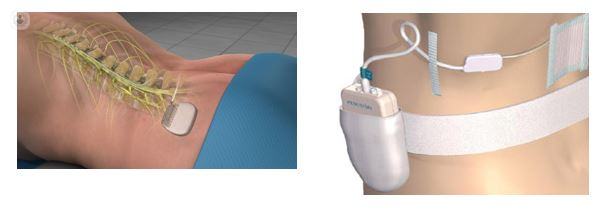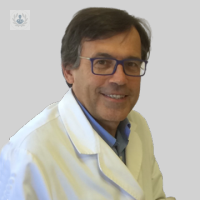Estimulación de médula espinal
Written by:People with back or neck pain who have not improved with back surgery and who have not improved with other treatments such as nerve blocks, medication or physiotherapy, have another option to consider: spinal cord stimulation .
Stimulation of the spinal cord was used for the first time to treat pain in 1967. This treatment was approved by the FDA in 1989 and there are currently around 14,000 patients worldwide who undergo implants to control pain.
What is spinal cord stimulation?
Spinal cord stimulation (SCS) provides a mild electrical stimulation to the nerves along the spine, modifying or blocking the pain impulses that reach the brain, which is what we call neuromodulation.
This technique, also called neurostimulation, involves the introduction of electrodes or special cables at the level of the spine that direct the electrical impulses to interfere with the pain signals that reach the brain.. These electrodes are connected to a small battery called a generator, which is implanted under the skin at the abdominal or gluteal level. The implanted generator or battery used in stimulating the spinal cord has similarities to a cardiac pacemaker, which leads some to call the device a pacemaker for pain.
Who can benefit from spinal stimulation
Neurostimulation has been used for decades and is recommended for an increasing number of conditions. The most frequent case is the so-called back surgery surgery syndrome. The term describes chronic pain after one or more back or neck surgeries that fail to relieve back pain or pain in the legs (sciatica or lumbar radiculopathy) or pain in the arms (cervical radiculopathy). Although it is used more and more in other types of neuropathic pain that do not respond to conventional treatment such as:
- neuralgia pudenda
- occipital neuralgia
- intercostal neuralgia (postoracotomy)
- Inguinal neuralgia (post-inguinal hernia surgery)
- Complex regional pain syndrome
- diabetic neuropathy
- In addition to other processes such as peripheral vasculopathy and angina refractory to treatment
Test phase
Before deciding whether a patient is a candidate for the implantation of a neurostimulation system, since not everyone will benefit from it, it has to be examined by the doctor and, in many cases, a psychological evaluation will also be necessary.
If the patient meets the criteria for spinal cord stimulation the doctor will organize a so-called trial period.
In the test phase, the first step consists of implanting the electrodes (1 or 2) in the operating room, with local anesthesia and sedation, at the level of the spine (in case of lumbar, cervical or limb pain) or subcutaneously in other types of neuropathic pain.

Currently there are 2 types of neurostimulation:
- Conventional stimulation, with which the patient feels a tingling sensation in the area where the pain is felt, such as extremities or lower back
- High frequency stimulation: the patient does not notice anything
The electrodes in both cases are the same and are placed at the subcutaneous level, leaving a point on the skin where they are connected to an external device that will administer the necessary electrical pulses during the test phase.

The doctor establishes a program in the device that will allow the patient to administer the electrical impulses according to the intensity of pain and other factors such as body movements (getting up or going to bed), which vary throughout the day.
After implantation of the electrodes, the patient can go home as an outpatient procedure and in some cases may be hospitalized for 1 day.
During a period of 1 to 3 weeks the patient will use the programmed stimulation program. Once this time has passed, the doctor, together with the patient, will assess whether the system is effective in relieving pain.
If the pain has improved, in a second phase, the final generator or battery will be implanted.
This is also done in the operating room, with anesthesia and sedation. The patient usually goes home after the procedure.



